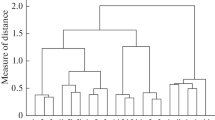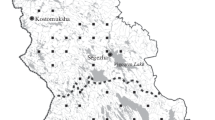Abstract
The morphological structure of the soils in the forest areas of European Russia was analyzed. It was shown that most of the soils were formed under the impact of both biotic and anthropogenic factors. Soils with poorly differentiated profiles without podzolization features are typical for the least disturbed forest ecosystems. The presence of an eluvial (EL) horizon is associated with the signs of old plowing and (or) fires. The character and rate of the soil cover transformation under various impacts of the historical land use (felling, plowing, pasturing, burning, etc.) are discussed. The technologies of the main traditional farming systems in the forest zone of European Russia (slash-and-burn, fallow, and shifting farming systems) are considered; their effect on the long-term dynamics of the soil cover is estimated. Farming and the related impacts of historical land use can be a major reason for the formation of degraded soils in the forest zone of European Russia.
Similar content being viewed by others
References
A. L. Aleksandrovskii and E. I. Aleksandrovskaya, Evolution of Soils and the Geographical Environment (Nauka, Moscow, 2005), 223 pp. [in Russian].
V. F. Basevich, V. N. Bgantsev, and I. B. Makarov, “Evolution of Soil Cover Structures at Early Stages of the Agricultural Development of Podzolic Soils,” in Evolution of Soil Cover Structures and the procedure of Their Examination (Byull. Pochv. Inst. im. V.V. Dokuchaeva, Moscow, 1988), No. 47, pp. 12–13 [in Russian].
M. V. Bobrovskii, Forest Soils of European Russia: Biotic and Anthropogenic Factors of Formation (KMK, Moscow, 2010) [in Russian].
East-European Forests: History in the Holocene and the Present State, Ed. by O. V. Smirnov (Nauka, Moscow, 2004), Vol. 1, 428 pp. [in Russian].
M. I. Gerasimova, S. V. Gubin, and S. A. Shoba, Micromorphology of Soils in the Natural Zones of the Soviet Union (Pushchino, 1992) [in Russian].
Degradation and Conservation of Soils, Ed. by G. V. Dobrovol’skii (Mosk. Gos. Univ., Moscow, 2002), 654 pp. [in Russian].
N. A. Karavaeva, “Agrogenic Soils: Environmental Conditions, Properties, and Processes,” Pochvovedenie, No. 12, 1518–1529 (2005) [Eur. Soil Sci. 38 (12), 1355–1365 (2005)].
N. A. Karavaeva, S. N. Zharikov, and A. E. Konchin, “Arable Soils of the Nonchernozemic Zone: Process-Evolution Approach to Their Study,” Pochvovedenie, No. 11, 114–125 (1985).
Classification of Russian Soils (Pochv. Inst. im. V.V. Dokuchaeva, Moscow, 1997), 235 pp. [in Russian].
E. A. Kornblyum, “The Main Levels of the Morphological Organization of Soil Matter,” Pochvovedenie, No. 9, 36–48 (1975).
A. V. Korolev, Agriculture in Northwestern Regions of the Nonchernozemic Zone (Leningrad, 1982), 176 pp. [in Russian].
L. V. Milov, Great Russian Plowman and the Peculiarities of the Russian Historical Process (ROSSPEN, Moscow, 1998), 573 pp. [in Russian].
Global Correlation Database of Soil Resources: Basis for the International Classification and Correlation of Soils (KMK, Moscow, 2007), 278 pp. [in Russian].
G. F. Morozov, Essays on Silviculture (Goslestekhizdat, Moscow, 1950), 213 pp. [in Russian].
Assessment and Conservation of Forest Cover Biodiversity in the Reserves of European Russia, Ed. by L. B. Zaugol’nova (Nauchnyi Mir, Moscow, 2000), 185 pp. [in Russian].
E. V. Ponomarenko, “Methodological Approaches to the Analysis of Succession Processes in Soil Cover,” in Succession Processes in Russian Reserves and the Sustenance of Biological Diversity, Ed. by O. V. Smirnova and E. S. Shaposhnikov (RBO, St. Petersburg, 1999), pp. 34–57 [in Russian].
E. V. Ponomarenko, “Soil-Morphological Signs of Anthropogenic Changes in Forest Cenoses,” in Population Organization of the Plant Cover of Forest Areas) (Pushchino, 1990), pp. 66–81 [in Russian].
N. P. Remezov and P. S. Pogrebnyak, Forest Soil Science (Lesnaya Promyshlennost’, Moscow, 1965), 324 pp. [in Russian].
V. P. Samsonova, E. A. Dmitriev, and V. G. Vityazev, “Spatial Organization of Morphological Profiles and Specific Surface in Arable Soddy-podzolic Soil,” Pochvovedenie, No. 10, 1200–1206 (1997) [Eur. Soil Sci. 30 (10), 1069–1074 (1997)].
O. V. Smirnova, M. V. Bobrovskii, L. G. Khanina, and V. E. Smirnov, “Succession Status of Old-Aged Dark Coniferous Forests in European Russia,” Usp. Sovrem. Biol. 126(1), 27–49 (2006).
O. V. Smirnova, S. A. Turubanova, M. V. Bobrovskii, et al., “Reconstruction of the History of the Biocenotic Cover of Eastern Europe and the Sustenance of Biological Diversity,” Usp. Sovrem. Biol., No. 2, 144–159 (2001).
V. D. Tonkonogov, Clay-Differentiated Soils of European Russia (Pochv. Inst. im. V.V. Dokuchaeva, Moscow, 1999), 156 pp. [in Russian].
Traditional Land Use Practice in Russia, Ed. by L. V. Danilova and A. K. Sokolov (Nauka, Moscow, 1998) [in Russian].
P. N. Tret’yakov, Swidden Farming in the Eastern Europe (Leningrad, 1932), 39 pp. [in Russian].
T. V. Tursina, N. E. Rubilina, and I. V. Kuznetsova, “Changes in the Microstructure of Humus Horizons of Soddy-Podzolic Soils under Cultivation,” Pochvovedenie, No. 7, 15–25 (1982).
M. V. Bobrovskii, “The Role of Windfall Pedoturbations in the Formation of Forest Soil Profiles,” Eur. Soil Sci. 13, 1366–1370 (2008).
C. J. Bronick and R. Lal, “Soil Structure and Management: a Review,” Geoderma 124, 3–22 (2005).
C. Carcaillet, H. Almquist, H. Asnong, et al., “Holocene Biomass Burning and Global Dynamics of the Carbon Cycle,” Chemosphere 49, 845–863 (2002).
D. Foster, F. Swanson, J. Aber, et al., “The Importance of Land-Use Legacies to Ecology and Conservation,” BioSci. 53(1), 77–88 (2003).
F. D. Hole, “A Classification of Pedoturbations and Some Other Processes and Factors of Soil Formation in Relation to Isotropism and Anisotropism,” Soil Sci. 91, 375–377 (1961).
R. J. Huggett, “Soil Chronosequences, Soil Development, and Soil Evolution: a Critical Review,” Catena 32, 155–172 (1998).
D. L. Johnson, E. A. Keller, and T. K. Rockwells, “Dynamic Pedogenesis: New Views on Some Key Soil Concepts, and a Model for Interpreting Quaternary Soils,” Quat. Res. 33, 306–319 (1990).
A. Jongerius, “Some Morphological Aspects of Regrouping Phenomena in Dutch Soil,” Geoderma 4, 331–331 (1970).
M. Kleyer, R. Biedermann, K. Henle, et al., “Mosaic Cycles in Agricultural Landscapes of Northwest Europe,” Basic Appl. Ecol. 8, 295–309 (2007).
X. Liu, S. J. Herbert, A. M. Hashemi, et al., “Effects of Agricultural Management on Soil Organic Matter and Carbon Transformation: a Review,” Plant Soil Environ. 52(12), 531–543 (2006).
W. F. Ruddiman and E. C. Ellis, “Effect of Per-Capita Land Use Changes on Holocene Forest Clearance and CO2 Emissions,” Quat. Sci. Rev. (2009), doi: 10.1016/j.quascirev.2009.05.02.
J. Six, H. Bossuyt, S. Degryze, and K. Denef, “A History of Research on the Link between (Micro)Aggregates, Soil Biota, and Soil Organic Matter Dynamics,” Soil Tillage Res. 79, 7–31 (2004).
J. Six, E. T. Elliott, and K. Paustian, “Soil Macroaggregate Turnover and Microaggregate Formation: a Mechanism for C Sequestration under No-Tillage Agriculture,” Soil Biol. Biochem. 32, 2099–2103 (2000).
The Ecological History of European Forest, Ed. by K. Kirby and C. Watkins (Cambridge University Press, Cambridge, 1998).
J. M. Tisdall and J. M. Oades, “Organic Matter and Water-Stable Aggregates in Soils,” J. Soil Sci. 62, 141–163 (1982).
Author information
Authors and Affiliations
Rights and permissions
About this article
Cite this article
Bobrovskii, M.V. Effect of the historical land use on the structure of forest soils in European Russia. Eurasian Soil Sc. 43, 1458–1466 (2010). https://doi.org/10.1134/S1064229310130053
Received:
Accepted:
Published:
Issue Date:
DOI: https://doi.org/10.1134/S1064229310130053




